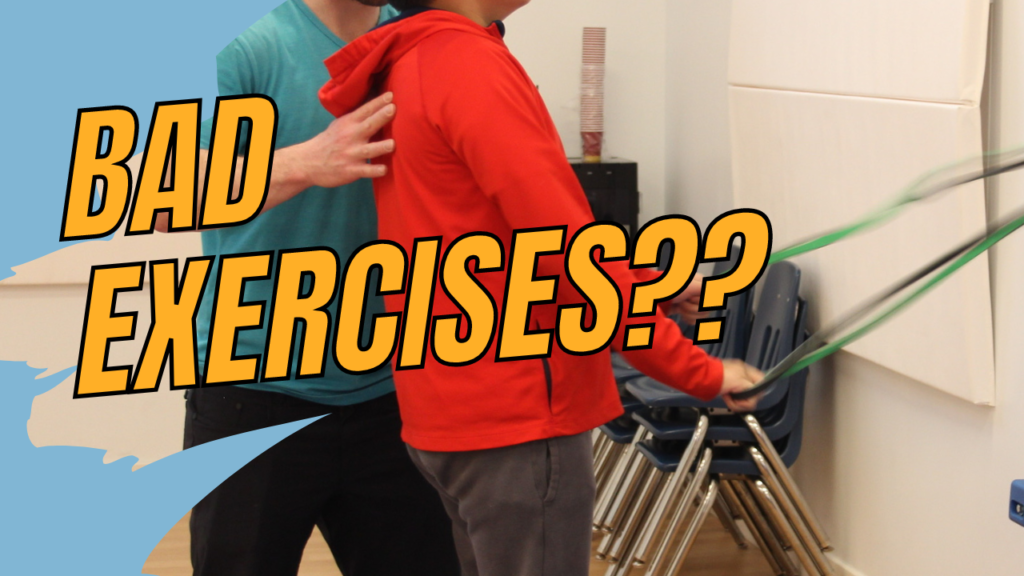Should certain exercises be avoided? How do you know which ones?
“Let’s start with arm circles and then a hula hoop dance then jumping jacks and then some band stretches.”
Is this a “good” exercise program? A “bad” exercise program? Does context matter?
🤔
(In the above example, I can assure you it’s pretty terrible)
But WHY?
What are the conditions and rules that make an effective exercise program different from an ineffective program for the ASD/ND population and to that extent…
What qualities differentiate a “good” exercise from a “bad” exercise for those with autism?
If we’re going to define these items, we need to discuss a few things…
Thing 1) Programming Goals
Thing 2) Human physiology
Thing 3) The science of exercise and hierarchies of movement
How do we determine exercise program goals for individuals with autism and related developmental disabilities? There are numerous considerations, along with deciding whether we’re focusing on general or specific skills. From a general perspective, the needs are not that much different from the neurotypical population; strength is going to be the foundation upon which other skills are built.
While this may appear straightforward; Most people need to focus on strength training as a basis for general physical abilities, for the autism population the premise is far simpler than the realities. The prevalence of strength and motor deficits means often starting with modified variations of basic strength exercises (squatting, pushing, pulling, carrying). The second challenge is kinesthetic awareness and body control. Individuals with autism and other developmental disabilities often display inhibited ability to control gross motor movements fluidly.
Programming goals that are either a random cornucopia of movements or highly specific are unlikely to have a training effect; the increase of strength and motor control that will generalize to novel activities and environments. Conversely, focusing on a moderate selection of strengthening exercises is a more productive approach.
Behavioral considerations (dysregulation, wandering, perseveration (verbal or physical) are another point of challenge. Exercises that require extensive setup, instruction, and/or a high degree of fine motor skill are often contraindicated. Additionally, strength exercises introduced at too high a level of challenge can invite compensatory movement, or a breakdown in stability and control.
If exercise selection is the initial buffer against poor exercise choice, the second is understanding the appropriate level of challenge (modification or progression) necessary to sustain integrity of the movement for the duration of each set ( x amount of repetitions).
We must also separate exercise from recreation for the autism population. Bike riding, hiking, and sports (competitive or otherwise). can all be excellent recreational activities and are certainly encouraged. Recreational pursuits, however, do not replace or supplement general strength training. So the question is not “Is bike riding a good form of exercise for autism?,” rather, “What are exercises that will both generalize to activities of daily living and to bike riding?”
The development of strength and motor skills for the ASD and neurodivergent population often requires a greater amount of ongoing repetition not only with specific exercises but at the same (or similar) levels of modification. For the neurotypical gym-goer or fitness enthusiast (levels of enthusiasm vary), initial progress in strength, stability, stamina, and coordination may have a relatively quick onset. A new trainee may go from 5lb to 10lb dumbbells in an overhead press within a few sessions.
Compare this with many children, teens, and adults with autism who may require session after session with the same amount of weight and coaching guidance to achieve basic mastery of the movement skill. With reference to the premise of ‘bad exercise choices,’ deviating from the current level of skill and progressing, or changing, the exercise removes the opportunity to benefit fully. While progress may occur slowly, with consistent and cumulative practice, individuals with autism can begin to not only master but generalize these new physical abilities.
Finally, exercises or activities that are too complex (multiple steps to complete), may appear desirable, however complexity is not the determining factor in choosing appropriate exercises. The addition of balance pods, unstable surfaces, jumping, spinning, etc. may have the appearance of a targeted effect, however this is often an illusion. Having a robust amount of movement does not satisfy the goal of movement that is stable, controlled, and sustained. Again, differentiating between effectiveness and complexity.
The video below provides more in-depth analysis of the ‘Bad Exercises for Autism’ conundrum. Click the picture to watch.

Eric Chessen, MS, is the Founder of Autism Fitness. Autism Fitness is a worldwide company dedicated to bringing the best fitness programming to the autism and neurodivergent population.